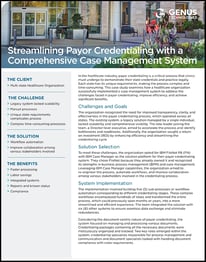THE CLIENT
- Multi-state Healthcare Organization
THE CHALLENGE
- Legacy system lacked scalability
- Manual processes
- Unique state requirements complicate processes
- Complex time-consuming processes
THE SOLUTION
- Workflow automation
- Improve collaboration among various stakeholders involved
THE BENEFITS
- Faster processing
- Labor savings
- Integrated systems
- Reports and known status
- Compliance
In the healthcare industry, payor credentialing is a critical process that clinics must undergo to demonstrate their state credentials and practice legally. Each state has its unique requirements, making the process complex and time-consuming.
This case study examines how a healthcare organization successfully implemented a case management system to address the challenges faced in payor credentialing, improve efficiency, and achieve significant benefits.
CHALLENGES AND GOALS
The organization recognized the need for improved transparency, clarity, and effectiveness in the payor credentialing process, which operated across all states. The existing system, a legacy solution managed by a single individual, lacked scalability and comprehensive visibility.
The new leader joining the team, a Director-level executive, aimed to accelerate the process and identify bottlenecks and roadblocks. Additionally, the organization sought a return on investment (ROI) by enhancing efficiency and streamlining the credentialing cycle.
SOLUTION AND RESULTS
To meet these challenges, the organization opted for IBM FileNet P8 (FN) with IBM Case Manager as the solution platform for their payor credentialing system. They chose FileNet because they already owned it and recognized its strengths in business process management (BPM) and case management.
Leveraging IBM Case Manager capabilities, the organization aimed to re-engineer the process, automate workflows, and improve collaboration among various stakeholders involved in the credentialing process.
SYSTEM IMPLEMENTATION
The implementation involved building five (5) sub-processes or workflow automation corresponding to different credentialing stages. These complex workflows encompassed hundreds of steps and transformed the entire process, which could previously span months or years, into a more streamlined and efficient experience. The team integrated the solution with six (6) other systems to ensure seamless data exchange and eliminate redundancies.
With the implementation of the new system, The organization gained an aggregated view of credentials, reducing the risk of losing critical information.
Considering the document-centric nature of payor credentialing, the system focused on managing and processing various documents. Credentialing packages containing all the necessary documents were meticulously organized and tracked. Two key roles emerged within the system: credentialing specialists responsible for process management and communication and document specialists tasked with handling document compliance with state requirements.
ACHIEVEMENTS AND BENEFITS
The organization set ambitious goals to minimize the credentialing cycle and gain insight into the time spent at each phase. With the implementation of the new system, they achieved these goals for the first time in over a decade. They gained an aggregated view of credentials, reducing the risk of losing critical information. The credentialing solution significantly reduced processing time, achieving two to three times faster processing.
As an additional benefit, the organization’s IT department assumed project ownership, eliminating the need for a dedicated person to manage and support the legacy system. This transition ensured ongoing maintenance, updates, and continuous improvements without relying on a single individual’s knowledge.
The payor credentialing system allowed the organization to track and manage all requirements by state and service. Historical views enabled them to monitor changes in requirements, ensuring compliance and staying up-to-date with evolving regulations. This comprehensive visibility empowered the organization to address emerging challenges and maintain high credentialing accuracy proactively.
SUMMARY
The healthcare organization overcame the challenges of payor credentialing by implementing a robust case management system using FileNet P8. They re-engineered the process, achieved greater transparency and efficiency, and minimized the credentialing cycle time.
The new system provided a stable and reliable platform that enabled prompt resolution of exceptions. Additionally, the organization gained the ability to track and manage credentialing requirements, ensuring compliance and adaptability to regulatory changes. This transformative solution improved operations and eliminated the need for a dedicated resource, resulting in long-term cost savings.
Ready to Propel Your Business Forward?
Fill out the form below to begin

